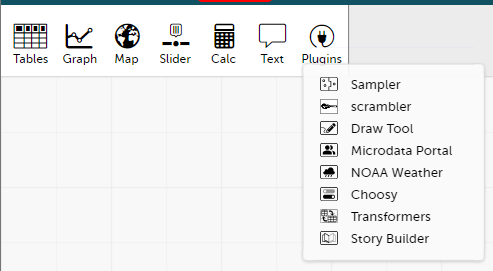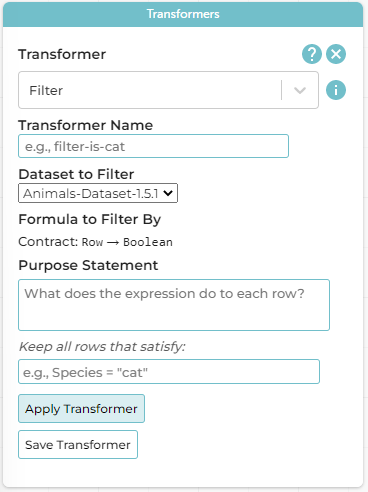Students learn two different ways to filter - by manually deleting table rows, and by using a Transformer to build and modify a copy of the table.
Lesson Goals |
Students will be able to…
|
Student-facing Lesson Goals |
|
Materials |
|
Supplemental Materials |
|
Key Points For The Facilitator |
|
🔗Manually Filtering Tables 10 minutes
Overview
Students learn how to filter tables by removing Rows.
Launch
What if the shelter needs to look at some information about only the dogs, or only the animals that have been fixed? There are many situations where, given a table, we want to filter out some of the rows and only look at a specific group from that table.
-
Open Animals Starter File.
-
Using what you’ve learned about deleting rows, create a table that includes only dogs.
In case students need a reminder, they can select the green index number for a row (left-most column) and then select "Delete Case" from the drop-down menu that appears.
How many dogs are in our dataset?
Debrief the activity above by inviting a few students to summarize the work they just completed. When possible, urge students to break down their process into a series of concrete steps (see below). This will prime them to better understand exactly what is going on in CODAP when the filtering happens nearly instantaneously (as will be the case in the subsequent portion of this lesson!).
To create a table with only dogs, here’s what we did:
-
We looked at the first row.
-
If
Species = "dog"was TRUE we kept the row. If it was FALSE we got rid of it. -
We moved on to the second row.
-
Again, we determined if
Species = "dog"was TRUE or FALSE. -
We repeated this process over and over, until we had inspected the entire table.
Did this feel efficient or like a good use of our time? Is anyone wishing for a simpler way… or noticing room for mistakes to get made? Did anyone maybe delete a dog row by accident - or maybe you missed a cat row?
Investigate
-
Create two filtered tables: one table with just dogs, and one table with all pets that weigh less than 32 pounds.
-
Make it so that these tables exist side-by-side within the same CODAP file, so we can discuss them together.
Allow students to give this task a try, but cut them off after a few minutes.
Students will likely run into major difficulties. Some may attempt to "undo" previous actions; some may hit "refresh" to reload the original file (effective, if they haven’t saved yet!); some may attempt to create a new blank table within the same file that they repopulate manually.
The goal is to manufacture a situation that will show students the need for an as-yet unfamiliar tool. This tool will require a bit of practice to master, but will enable much more efficient data manipulation!
Synthesize
-
What problems did you encounter when trying to manually filter the Animals dataset?
-
What strategies did you try in order to create two side-by-side filtered tables, one with just dogs and one with all pets that weigh more than 32 pounds?
🔗Filtering with Booleans 20 minutes
Overview
Students learn about a new data type, Booleans, and use them to filter data efficiently.
Launch
Enter: Transformers!
When we apply a Transformer, that Transformer creates a copy of the original dataset with whatever modifications we specify - for instance, Species = "dog".
The user simply needs to provide the Transformer with some key information, and select Apply. The original dataset is always preserved - meaning there is no need for students to undo their actions. In short, the Transformers plugin enables low-stakes "what if?" exploration.
Investigate
Open the Boolean Starter File, and turn to Booleans and Filters (1).
-
What do you Notice about the Transformer pictured on the left of the page?
-
Possible responses: The Transformer is named
filter-is-heavy. It looks like the Transformer is going to filter out animals that weigh more than 32 pounds. There is a Contract and a purpose statement. We can apply or edit the Transformer.
-
-
What do you Wonder?
-
Possible responses: I wonder if this Transformer will modify the dataset or create a new dataset. I wonder what that Contract is all about. I wonder what a Boolean is.
-
Wonderings will likely emerge about Contracts and Purpose Statements. You may want to devote a few minutes to discussing these important concepts.
-
A Contract is a statement of of the name, domain, and range of a Transformer’s expression. Contracts don’t tell us specific inputs. They tell us the data type of input the expression needs. For example, a Contract wouldn’t say that addition requires "3 and 4". Addition works on more than just those two inputs! Instead, it would tells us that addition requires "two Numbers". When we use a Contract, we plug specific numbers or strings into the expression.
-
A Purpose Statement is a way of describing what a Transformer’s expression does. Purpose Statements in CODAP begin with either "Checks…" or "Computes…". For example, "Checks the row to see whether the species is a dog", or "Computes the sum of
Ageand 2."
Students who wondered what a Boolean is are in luck…
-
On the second section of Booleans and Filters (1), predict whether each Boolean expression is
trueorfalse. -
When you’re done, move onto Booleans and Filters (2).
Synthesize
-
What sets Booleans apart from the other data types we’ve explored, Strings and Numbers?
🔗Creating Filter Transformers 20 minutes
Launch
Now that we understand how Booleans can help us to filter datasets, we are ready to create our very own Transformers from scratch!
Investigate
-
Open the Animals Starter File.
-
At the start of the page, you will be asked to select the Plugins icon, then choose Transformers. The screenshot below illustrates how to do that.

-
Complete the worksheet Filter to explore the functionality of the
FilterTransformer. -
Get extra practice Writing Purpose Statements & Expressions.
-
On Writing Examples from Purpose Statements, provide some sample rows from the original dataset and then show what the transformed table would look when given a Purpose Statement.
As students complete the page, encourage them to pay close attention while entering information into the Transformer plugin (pictured below).

-
What happens if you forget to select a dataset from the drop-down menu?
-
An error message appears: "Please choose a dataset to transform."
-
-
When does the text color change?
-
Strings appear in brown. When we enter an attribute, that text turns pink.
-
-
Does CODAP mind if spelling is off?
-
CODAP will not recognize a misspelled attribute; an error message will appear saying the attribute is unrecognized.
-
-
What happens when you save a Transformer?
-
A new box appears with the Transformer’s name at the top.
-
-
Can you predict any value in saving a Transformer?
-
If I save a Transformer, I can use it whenever I’d like!
-
-
Why might a clear, specific purpose statement be useful?
-
If I save my Transformer, I will want to easily recognize what it does to the dataset.
-
Students should observe that new and modified tables created by Transformers are automatically saved. Each new table is titled first with the Transformer name, then the name of the dataset (in parentheses). Students may rename saved tables, if they’d like. Highlight for students that, each time they apply a saved Transformer, the new datasets that are created will appear in the Transformer’s "Dataset to sort" drop-down menu.
Synthesize
-
What is the role of the
FilterTransformer? How is its role unique from that of the Transformer’s expression?-
The
FilterTransformer walks through the table’s rows, applying the expression to each row - then producing a new table containing only rows for which the expression returnstrue.
-
-
Suppose we wanted to determine whether cats or dogs get adopted faster. How might using the
FilterTransformer help?-
We could use the
FilterTransformer to produce two new tables - one with only cats, and one with only dogs. We could then analyze and compare the weeks to adoption for each species.
-
-
If the shelter is purchasing food for older cats, what
FilterTransformer would we create to determine how many cats to buy for?-
We would filter out cats where
Age (years) > 5.
-
-
When applying Transformers, what did you notice about how transformed datasets were named?
-
How is saving a Transformer different from saving a dataset?
These materials were developed partly through support of the National Science Foundation, (awards 1042210, 1535276, 1648684, 1738598, 2031479, and 1501927).  Bootstrap by the Bootstrap Community is licensed under a Creative Commons 4.0 Unported License. This license does not grant permission to run training or professional development. Offering training or professional development with materials substantially derived from Bootstrap must be approved in writing by a Bootstrap Director. Permissions beyond the scope of this license, such as to run training, may be available by contacting contact@BootstrapWorld.org.
Bootstrap by the Bootstrap Community is licensed under a Creative Commons 4.0 Unported License. This license does not grant permission to run training or professional development. Offering training or professional development with materials substantially derived from Bootstrap must be approved in writing by a Bootstrap Director. Permissions beyond the scope of this license, such as to run training, may be available by contacting contact@BootstrapWorld.org.
